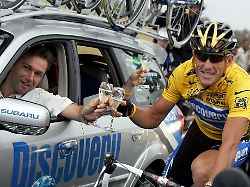Lifetime ban and forgiveness
Lance Armstrong kneels in front of his own pile of rubble
10/22/2022, 11:08 am
On October 22, 2012, record cyclist Lance Armstrong was convicted of doping and banned for life. He loses all his Tour de France titles and his career is finally in ruins. Ten years later, the head of the US Anti-Doping Agency recommends that Armstrong be forgiven.
A few weeks ago, Lance Armstrong sat on a Mallorcan terrace and recorded a podcast. A bunch of unusual guests were there: his former rival Jan Ullrich was one of them, as was top sprinter Mark Cavendish, who is still active. Armstrong seems to be back in the cycling circuit – a development that was unimaginable ten years ago.
Back then, on October 22, 2012, the Texan finally faced the ruins of his career: convicted, ostracized, banned for life. The biggest doping sinner in cycling history was stripped of seven Tour victories, as was Olympic bronze – Armstrong was not even allowed to keep his victory in the Rhineland-Palatinate Tour.
“It was a very important event for global sport,” recalls Travis Tygart, then as now head of the US anti-doping agency USADA, on the occasion of the tenth anniversary. “We have shown what happens when there is no control and why it is crucial to fight for justice in sport.” In the summer of 2012, USADA initially published its report on the Armstrong case. It describes the “most advanced and most successful doping program the sporting world has ever seen.” The world association UCI, which had stood by Armstrong’s side for an inglorious long time, finally confirmed the lifelong ban under public pressure.
No second chance for Armstrong
Some time later, the suspect unpacked himself: Armstrong admitted his transgressions to TV presenter Oprah Winfrey – at least in part. “The whole truth will probably never come out. But the most important thing was that he admitted his crimes,” says Tygart. The 51-year-old knows what he’s talking about: With his investigations, he was instrumental in uncovering the nationwide doping system in cycling in the 1990s and 2000s.
Since Armstrong played a major role in this system, he didn’t get a second chance in 2012 – unlike other drivers: “That was primarily because he not only used doping substances, but also dealt with them,” Tygart explains lifetime ban. “In addition, he has lied several times under oath.” Tygart has no grudges against Armstrong today – despite numerous attempts to discredit the investigator and despite his failed processing culture: “We should all forgive him, because it was never about Lance personally,” he says: “There was just a dirty culture in this one Cycling era. Our goal was to dismantle this corrupt system.”
Ten years later, this seems to have succeeded. According to Tygart, cycling has made great strides: “It’s like day and night. We’re seeing a culture of clean sport again, and the tools to fight doping are much better today.” And Armstrong is meanwhile returning to the cycling public – also in Germany. In an ARD documentary, the 51-year-old recently described how he had stood by the fallen Ullrich in his most difficult hours. Since then, the two have been linked by a male friendship – including joint bike rides and podcast recordings on Mallorca.
Ten years after Armstrong’s doping empire finally collapsed, both cycling and its most famous imposter appear to have recovered. “I’ve wished Lance nothing but the best since his confession,” says Tygart. He looks like he means business.
